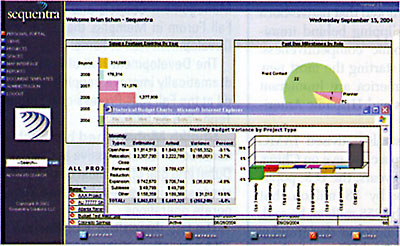Technologies, is in the midst of a program aimed at centralizing real
estate operations with a goal of realizing $50 million in occupancy
cost savings. Headquartered in Hartford, Conn., United Technologies
is a $31-billion company and ranks as the 22nd largest U.S. manufacturer
according to Industry Week. Efficiently managing the company’s massive
real estate portfolio presents a major challenge.
To help accomplish its goal, UT Realty selected
Sequentra software from Sequentra Solutions LLC (www.sequentra.com),
a subsidiary of United Systems Integrators. UT Realty has been using
the software for nearly two years and gives it positive reviews for
helping manage about 4,100
|
United Technologies’ property portfolio, spanning
66 countries, is ripe for centralized management.
|
properties in 66 countries across seven business units.
“We use it on a global basis to manage all of our
real estate projects and maintain all information about our real estate
portfolio,” says Taylor Henderson, global finance and operations manager
for UT Realty.
So, for example, if Henderson wants to see how
much monthly rent UT subsidiary Sikorsky Helicopter is paying at a particular
location, he just goes to the specific location on the Web created for
that site and pulls up the rent tab. He also uses it to find information
internationally, such as the total square footage and number of sites
in a given country.
“We use it to ID different projects in a country
or business unit,” Henderson says. “We can determine how many lease
renewals are happening in the U.K. and we can pull all the information
right out of the system. It’s truly changed the way we work here at
UT Realty. We’ve gone from a position of relying on individuals outside
of our organization and outside of our control. It’s an extremely powerful
tool and it allows us to understand what our real estate portfolio is
and how to manage it.”
That kind of centralization is in line with the
strategy implemented under UT Realty President Ron Zappile (profiled
in the May 2003 issue of Site Selection), whose “Project Landlord” and
“Project Intrinsic Value” have had savings and value discovery as their
chief goals.
 |
Sequentra’s capabilities have enabled customers like United Technologies to better understand and better manage their real estate portfolios. |
“When you have as many facilities and as much real
estate as we have,” Zappile told Site Selection, “there are opportunities
that present themselves all across the globe.”
What’s more, using the right tools and processes
gives corporate real estate the opportunity to maximize value.
“We wanted to make sure we had the right data,
because as you look at co-locations and consolidations and opportunities,
if you don’t have the right data, you don’t make the right decisions,”
Zappile said.
Henderson says there’s constant communication between
his company and Sequentra regarding the product’s use.
“Every two weeks, I manage a global conference
call where we have on average about 15 players, one of whom is a Sequentra
consultant. Also, we as a company talk about how it’s doing and how
we would like it to improve and we ask for advice if we need it.”
Henderson hopes to eventually organize a users’
group to discuss issues with other companies using Sequentra.
Sequentra Solutions is continually enhancing its
Sequentra real estate technology software. Developed about six years
ago, the software has gone through several versions and upgrades and
is now gaining a sizeable client base of major corporations.
Garrett Cannon, senior vice president and CIO of
Sequentra Solutions, describes Sequentra as a single interface for all
corporate real estate activities, available through the Web and allowing
collaboration by all types of people.
“Sequentra drives the efficiency of the whole real
estate department, leveraging technology to make them more efficient,”
Cannon says.
Because Sequentra is entirely Web-based, users
do not need anything installed on their machines. Sequentra officials
cite this as a key benefit as it allows access from any PC connected
to the Internet. The software offers two modules: project tracking and
lease administration.
“Anything with a process behind it can be tracked,”
says Brian Schan, Sequentra product development manager. Schan says
a central focus of Sequentra is its Milestones section, which associates
tasks and responsibilities with individuals.
Sequentra offers flexibility and can be tailored
to companies with portfolios containing a couple dozen sites or several
thousand. Users range from standard offices to large manufacturers to
technology companies. Sequentra clients license the software through
an agreement that allows them use of the system. The agreement is generally
for a 3- to 5-year term with options to extend.
“It’s easily configurable for different types of
clients,” Cannon says. “They can add as many custom fields and custom
reports as they want just by being a normal user.”
Cannon says the Sequentra product was built specifically
with corporate real estate departments in mind.
“Since it’s geared for corporate real estate executives,
it has a savings module that’s unique and can be used to track savings
on each individual project,” Cannon says. “It’s pretty innovative today
with companies trying to squeeze savings out of every area. ”
Plans call for new modules to be added for space
management that will allow users to integrate CAD drawings to track
assets such as furniture and equipment at individual sites. Also in
the works is a GIS mapping interface.
Sequentra issues new releases about every two months
and clients have the option of adding the new features, Cannon says.
